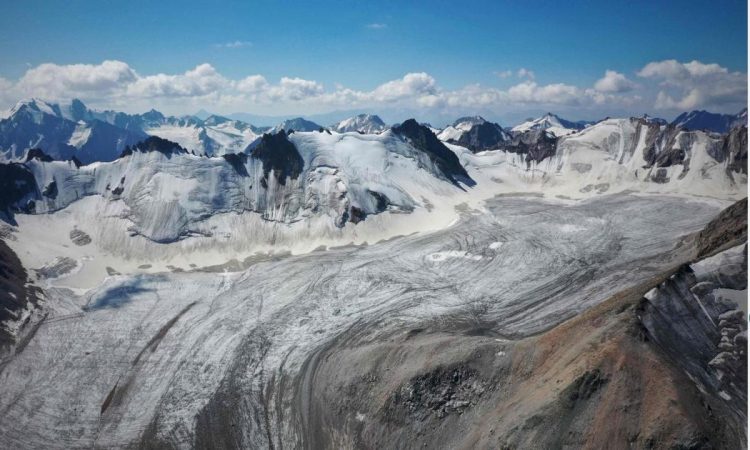
Adygene Glacier in the Tian Shan Mountains in High Asia (Kyrgyzstan)
© APA/AFP/ARSENY MAMASHEV / ARSENY MAMASHEV
glacier are located at enormous heights, are difficult to access and spread over large areas. They are also dynamici.e. grow and melt to different extents. This makes it difficult to observe and measure them.
You can examine them selectively and derive projections from them. However, the use of has become much more important in recent years Satellite data established.
In this country, for example, it is used to document how much a glacier in Salzburg has retreated. Just recently, a recording of the… Stubacher Sonnblickkeesthat this has been around for the past 25 years 45 million cubic meters shrank. This means that it lost almost half of its total mass.
Radar datalike that of the European Sentinel-1 satellites, provide new information about the composition of glaciers worldwide. In some regions, for example in Asia, the glaciers at enormous altitudes have not yet been well researched.
now investigated the growth of glaciers, the so-called accumulation. It was created as part of the “Dragon 5” collaboration between the European Space Agency ESA and Chinawith the participation of YOUR Graz.
“Dragon” is a collaboration between the European Space Agency (ESA) and the Chinese Space Agency’s Ministry of Science and Technology (MOST). It has existed since 2004. The collaboration is currently in its final phase.
55 research teams from Europe and China worked on 10 projects as part of Dragon 5. Topics of climate research, earth observation and the environment are covered.
Summer and winter accumulation
“Here in the Alps everyone knows: in winter it is cold, snow falls and the glaciers have increased in mass,” from the Institute of Geodesy at Graz University of Technology in conversation with futurezone. But in some glacier areas things are different, for example in High Asiai.e. in the eastern parts of the Himalayasor the mountains of the Tibetan Plateau. The glaciers there are sometimes on top 6,000 meters. “It’s extremely cold and very dry there in winter,” says Bolch. It is therefore assumed that hardly any precipitation falls there.
➤ Read more:
Instead, weather phenomena like this cause concern Monsoon that some of the glaciers in the Sommer grow. Then there is enough precipitation, due to the altitude, the rain turns into snow and the glacier gains mass. Until now, however, it has been difficult to find out which glaciers grow at which time of year.
Radar data looks through clouds and snow
Together with an international team of researchers, Bolch has examined the glaciers of High Asia using the Radar data examined. “The satellite is actively transmitting Microwaves that can penetrate cloud cover,” says Bolch. This is particularly important during the monsoon seasons in summer, as you cannot work with optical images during this time.
Radar can also look beneath the snow cover. The data shows the exact boundaries between fresh snow, wet snow, Eis and Firn to. Firn is deposited snow that is at least one year old.
➤ Read more:
Sentinel-1 collects all of this data 12 Roofs. The researchers collected and compared them over several years to get an accurate picture of glacier melt and growth. Among other things, it was shown that growth in the eastern Pamir Mountains and large parts of the Himalayas predominantly takes place in winter.
Previously, it was assumed that these glaciers grew in summer, because that is when most of the precipitation falls there. This assumption was concluded from measurements that were made significantly deeper in the valley and transferred to higher altitudes.
With the help of the satellite data, the researchers were able to get a concrete picture of the glaciers and update previous assumptions. The glacier growth in winter could be explained by one Increase in precipitation. This is achieved, among other things, by the Westwinde that affect the region in winter. However, the phenomenon has not yet been examined in detail.
Adaptation of climate models
This has, among other things, effects on the Climate- and Glacier model calculations. The new findings can be included in the model calculations. “Glaciers that grow primarily in summer have significantly higher mass losses than those that gain mass in winter,” explains Bolch.
➤ Read more:
“Glaciers are Water storage made of ice that release water in the summer,” says Bolch. The runoff meltwater is particularly important in the very dry region of High Asia as it irrigates the area. “Summer runoff is an important source for life and the agriculture“.
Dangers from growing glacial lakes
At the same time, this is also changing Danger situation through the Glacier retreatsaid Bolch. The more the glaciers retreat, the larger Gletscherseen created with meltwater.
If the amount of water is too large, the dams can break and it can spill Tidal waves into the valley, the infrastructure and important agricultural areas can destroy. “This happens at regular intervals,” says Bolch. In addition, the slopes are destabilized by the retreating glacier, which is why landslides can occur more frequently.
The glaciers in High Asia have been observed by researchers for years. 2022 has one examined these problems. Due to the constant rise in temperature due to the climate catastrophe and the resulting increasing melting of glaciers, the glacial lakes in High Asia will increase sharply in the coming years. The water volume of the glacial lakes may even increase by 2100 increase tenfoldthey concluded.
More glacier lakes in Salzburg too
There will be more and more glacial lakes . Due to the melting of glaciers, more and fuller glacial lakes are expected there – by 2100 260 to the 1.500 Seen in the high mountains. The effects are still being researched. It is obvious that the dams can break here too and the water flowing off can cause damage.

